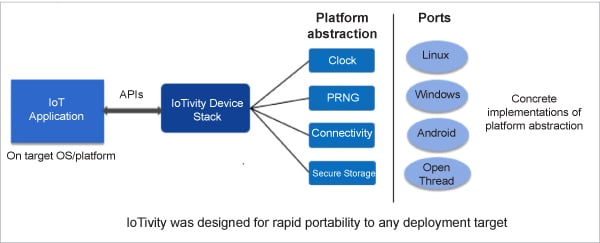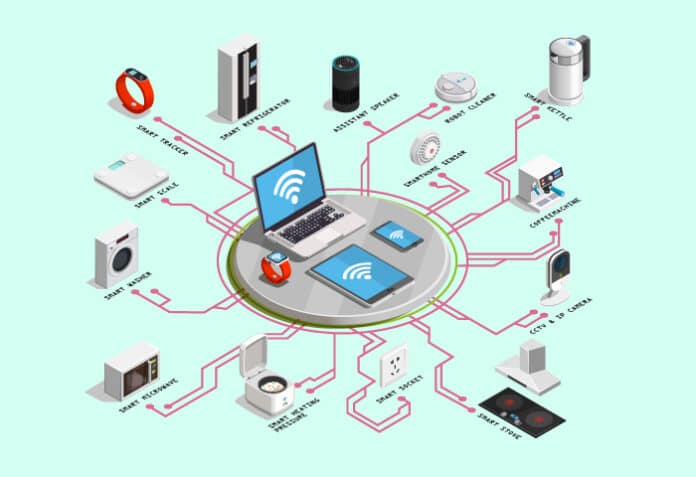With a burgeoning ecosystem of stakeholders, IoTivity is poised to shape the future of IoT, fostering innovation and enhancing the lives of individuals and organisations around the globe. What makes it special is a deep commitment to open source principles.
The Internet of Things (IoT) has been reshaping our world, bringing convenience and connectivity to every corner of our lives. We’ve witnessed smart homes that adjust the temperature before we even think of it and industrial setups that run like clockwork, thanks to IoT. But amid all the marvels, a significant challenge looms: how do we get these devices to talk to each other seamlessly, regardless of who made them or what language they speak? That’s where the Open Connectivity Foundation (OCF), now IoTivity, comes in.
IoTivity is an open source software project enabling seamless device-to-device connectivity. It helps billions of wired and wireless IoT devices securely connect to each other and to the internet. The Open Connectivity Foundation (OCF) develops specifications, interoperability guidelines, and a certification program for these devices.
Let’s discover the story of IoTivity, its mission, and why it matters in the IoT universe.
The birth of IoTivity
IoTivity’s journey began back in 2014 when the Open Interconnect Consortium (OIC) was born. Its mission was clear: establish open standards for IoT device communication and interoperability. Two years later, in 2016, the OIC underwent a transformation and rebranded itself as the Open Connectivity Foundation (OCF), broadening its horizons to encompass more than just connectivity.
At its core, IoTivity was driven by a singular purpose — creating a world where IoT devices could communicate effortlessly, transcending boundaries set by manufacturers or communication protocols. The vision was to ensure that smart devices collaborated harmoniously, offering enhanced user experiences while maintaining stringent security.
Open source, open possibilities
The key to IoTivity’s success lies in its unwavering commitment to open source principles. IoTivity provides an open source software framework that acts as a blueprint for implementing their standards. This open source approach is a game-changer. It fosters collaboration, empowering developers and organisations to embrace these standards without being shackled by proprietary solutions.
IoTivity’s open source ethos encourages innovation. It paves the way for startups and tech giants alike to join hands in refining and expanding IoT standards. With a common framework and protocols, IoTivity quickens the pace of IoT solution development, ensuring compatibility across different ecosystems.
Interoperability: The heartbeat of IoTivity
At the heart of IoTivity’s mission lies interoperability — the ability of devices from diverse origins to communicate seamlessly. IoT encompasses an array of devices, each using distinct communication protocols and technologies. Without interoperability, these devices remain isolated silos, limiting their utility.
IoTivity tackles this challenge head-on by defining open standards that promote interoperability. These standards cover a wide spectrum of IoT aspects, including device discovery, data modelling, communication protocols, and security. By adhering to these standards, IoT device manufacturers ensure that their products can effortlessly communicate with devices from other manufacturers, creating a united IoT ecosystem.

Prioritising IoT security
Security is paramount in the IoT realm. The proliferation of connected devices creates new avenues for attacks, making it imperative to safeguard sensitive data and maintain system integrity. IoTivity takes security seriously, developing features and protocols to ensure secure device discovery and communication.
IoTivity’s security framework encompasses robust mechanisms for device authentication, secure data exchange, and access control. By incorporating these security features, IoTivity mitigates the risks associated with IoT, instilling trust among users and organisations embracing IoT solutions.
Standardisation for harmony
One of IoTivity’s most impactful contributions to the IoT landscape is the establishment of standardised protocols and specifications. These standards provide a common language for IoT devices and services, facilitating effective communication.
IoTivity leverages well-established internet protocols such as CoAP (Constrained Application Protocol)and HTTP for device communication. Moreover, it offers a framework for managing device resources and data models. These standardised elements simplify the lives of developers, enabling them to create IoT applications and services that work harmoniously with a wide range of devices.
A thriving ecosystem of innovation
IoTivity has cultivated a thriving ecosystem of member organisations. This ecosystem encompasses industry leaders, device manufacturers, and stakeholders deeply entrenched in the IoT landscape. These members unite to co-create and champion IoTivity’s standards and frameworks.
The diversity within this ecosystem ensures that IoTivity’s standards draw from a broad spectrum of perspectives and use cases. Furthermore, it promotes the adoption of these standards across various industries, spanning smart homes, healthcare, automotive, and industrial automation.
Real-world impact
IoTivity’s influence extends beyond theoretical standards and frameworks. Its practical applications manifest in real-world IoT projects and products. A shining example is the realm of smart homes.
IoTivity’s standards have revolutionised the smart home domain, enabling interoperability between devices from different manufacturers. This means our smart thermostat can harmoniously communicate with our smart lights, regardless of their respective brands. Such interoperability enhances user convenience and accelerates the adoption of smart home technologies.
In the healthcare sector, IoTivity has played a pivotal role in the development of connected medical devices that share data securely and reliably. This has the potential to elevate patient care, facilitate remote monitoring, and streamline healthcare operations.
Current state of IoTivity
IoTivity’s influence is palpable in diverse domains. We delve into the applications and sectors where it has made the most impact.
Smart homes: IoTivity’s standards have revolutionised the smart home domain, enabling interoperability between devices from different manufacturers. This means smart thermostats can harmoniously communicate with smart lights, regardless of their respective brands. Such interoperability enhances user convenience and accelerates the adoption of smart home technologies.
Healthcare: In the healthcare sector, IoTivity has played a pivotal role in the development of connected medical devices that share data securely and reliably. This has the potential to elevate patient care, facilitate remote monitoring, and streamline healthcare operations.
Industrial automation: IoTivity’s standards have found applications in industrial automation, where seamless communication between diverse machines and sensors is critical for optimising operations and ensuring safety.
Why to use IoTivity
IoTivity offers a host of compelling reasons to enhance your IoT endeavours. The most prominent ones are briefed below.
- Interoperability: By adopting IoTivity, we can ensure that our IoT devices can communicate seamlessly with other devices, regardless of their origins, making it easier to create comprehensive and integrated IoT solutions.
- Open source: IoTivity is an open source project, making its codebase freely available to developers and organisations. This open source nature encourages a broader community of contributors, lowers development costs, and speeds up the development of IoT solutions.
- Security: IoTivity places a strong emphasis on security. It includes features and protocols for secure device discovery, communication, and data exchange. By using IoTivity, we can leverage these built-in security features to protect our IoT ecosystem and sensitive data.
- Resource management: IoTivity provides a framework for managing device resources and data models. This simplifies the creation of IoT applications and services by providing a standardised way to interact with and manage IoT devices.
- Future-proofing: By adopting IoTivity, we future-proof our IoT solutions. As IoT evolves and new devices and technologies emerge, having a standardised and interoperable foundation ensures that our IoT ecosystem can adapt and grow without major disruptions.
The journey of the Open Connectivity Foundation, now known as IoTivity, stands as a testament to the power of open standards and collaboration in advancing the IoT landscape. Through its open source framework, the development of open standards, and a steadfast commitment to security, IoTivity has laid the foundation for a more interconnected and secure IoT ecosystem.
As the IoT world continues to evolve and expand, IoTivity’s contributions will remain instrumental in realising the vision of a seamlessly connected world.







































































